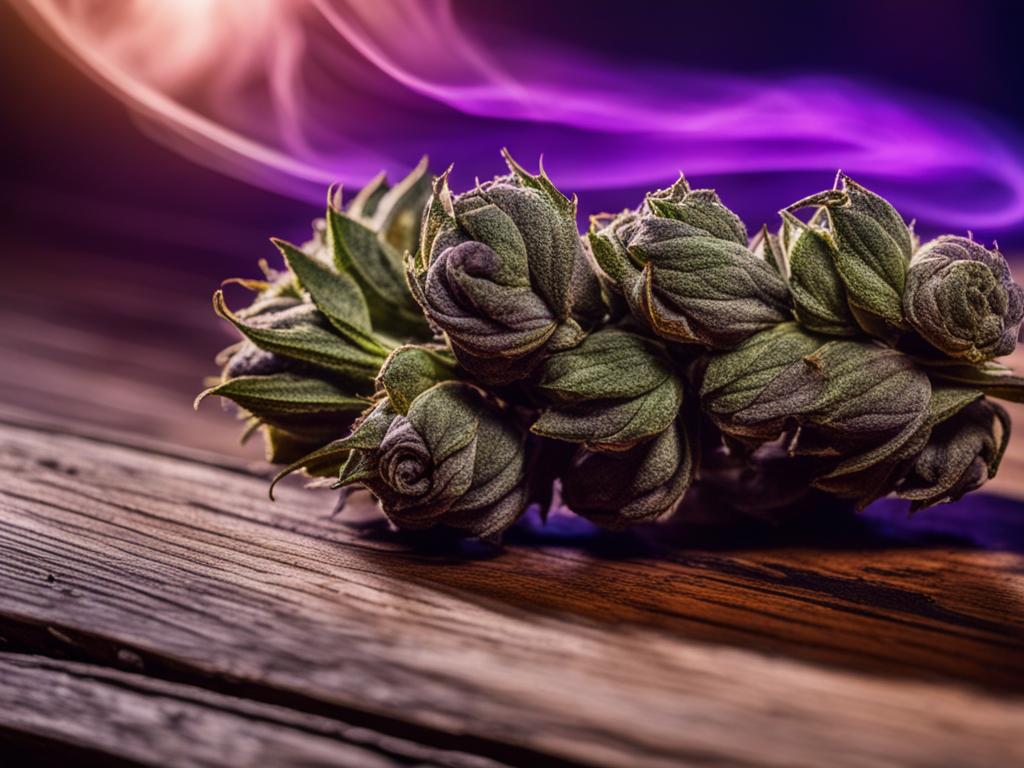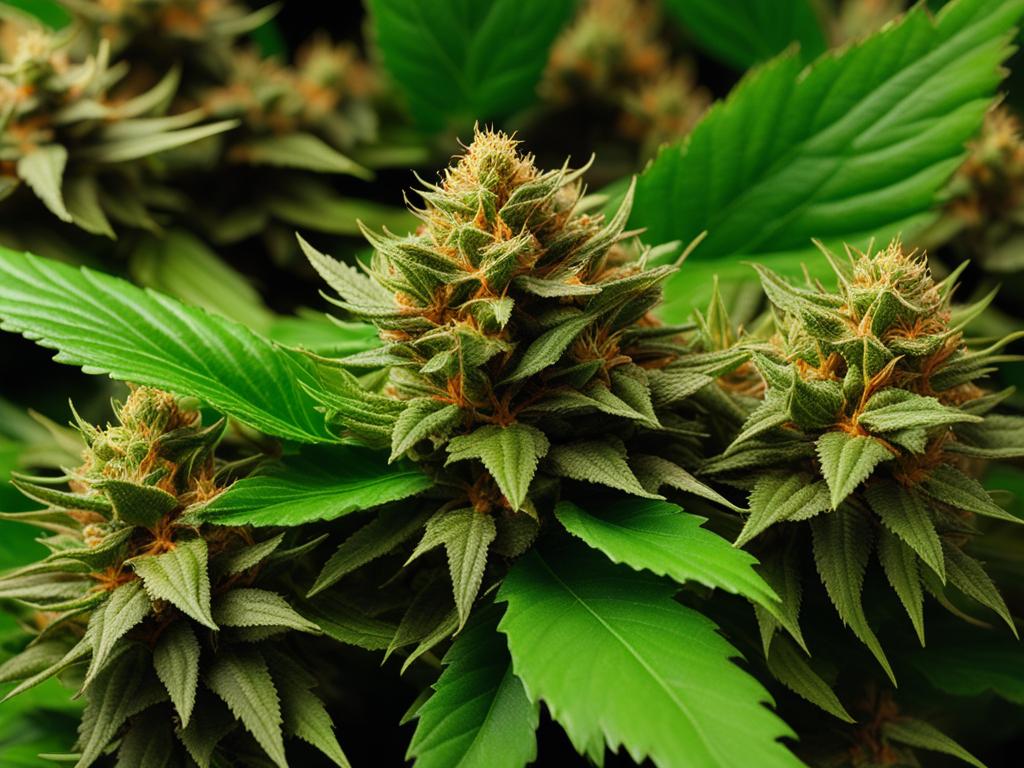Migraine headaches can be debilitating, with symptoms such as severe headache, nausea, sensitivity to light and sound, and disrupted balance. Traditional prescription medications may not provide complete relief for everyone. However, research suggests that cannabis, specifically indica strains, may offer an alternative treatment option for migraine relief. Indica strains of cannabis have been reported to have analgesic, anti-inflammatory, and antiemetic properties, making them potentially effective for managing migraine symptoms. Let’s explore the best indica strains for migraine relief.
Key Takeaways:
- Indica strains of cannabis may provide an alternative treatment option for migraine relief.
- They are reported to have analgesic, anti-inflammatory, and antiemetic properties.
- Research suggests that specific indica strains can effectively manage migraine symptoms.
- Choosing the right strain is essential for personalized migraine relief.
- Consult with a healthcare professional before considering cannabis for migraine treatment.
Purple Kush for Sweet Dreams
Purple Kush is a popular and easily accessible pure indica strain of cannabis. It is known for its deep purple hues and potent effects. This strain typically contains 17-22% THC and 0.07-0.1% CBD, making it a favorite among indica enthusiasts. The high THC content contributes to its psychoactive properties, while the low CBD levels result in a more intense cerebral effect.
“Purple Kush is like a nightcap in plant form. Its relaxing and sedating effects make it perfect for winding down after a long day.”
One of the main reasons people turn to Purple Kush is for its ability to induce deep, rejuvenating sleep. The strain provides a pleasant numbing sensation and a full-body relaxation that can help ease the symptoms of migraines. Many users find that Purple Kush not only helps them fall asleep faster but also improves the overall quality of their sleep.
The Science Behind Purple Kush
The therapeutic effects of Purple Kush can be attributed to its unique chemical composition. The high THC levels in this strain contribute to its analgesic properties, helping to alleviate pain associated with migraines. THC also acts as a muscle relaxant, reducing tension and promoting relaxation.
| Chemical | Percentage |
|---|---|
| THC | 17-22% |
| CBD | 0.07-0.1% |
While Purple Kush is known for its sleep-inducing effects, it is important to note that the strain can also cause drowsiness and lethargy. It is best to use Purple Kush in the evenings or when you have time to relax and unwind. As with any cannabis strain, individual reactions may vary, and it is recommended to start with a low dosage and gradually increase as needed.
Overall, Purple Kush is a popular choice for those seeking an indica strain to help alleviate migraines and promote restful sleep. Its relaxing and sedating effects make it an excellent option for individuals looking to unwind and find relief from migraine symptoms.
OG Kush: A Reliable Option for Migraine Relief
Migraines can be incredibly painful and disruptive, causing severe headaches, nausea, and sensitivity to light and sound. Finding effective relief can be challenging, but cannabis has emerged as a potential alternative treatment for migraine symptoms. One strain that stands out is OG Kush, known for its analgesic effects and ability to alleviate migraine symptoms.
OG Kush is a well-known cannabis strain that is often recommended for migraine relief. With its high levels of THC, typically around 20%, it offers potent pain-relieving properties. Many patients have reported that OG Kush helps reduce the severity and frequency of migraines, providing much-needed relief.
“OG Kush has been a game-changer for my migraines. It helps me manage the pain and discomfort without any harsh side effects.”
In addition to its analgesic effect, OG Kush also offers a sense of relaxation and calm, which can further aid in migraine relief. It helps promote a state of tranquility that can alleviate stress and tension, both of which can trigger migraines.
The Benefits of OG Kush for Migraine Relief
- High levels of THC provide potent analgesic effects
- Helps reduce the severity and frequency of migraines
- Promotes relaxation and reduces stress, common triggers for migraines
If you’re considering trying OG Kush for your migraines, it’s important to consult with a healthcare professional to ensure it’s a suitable option for you. They can provide guidance on dosage, potential interactions with other medications, and any potential side effects.

Table: Comparing the Top Strains for Migraine Relief
| Strain | THC Level | CBD Level | Analgesic Effect |
|---|---|---|---|
| OG Kush | High (around 20%) | Low | Effective in reducing migraine symptoms |
| Purple Kush | Medium (17-22%) | Low | Induces deep, rejuvenating sleep for migraine relief |
| White Widow | Medium-high (18-25%) | Medium | Relaxes the body and promotes creativity |
| Chocolope | Medium (15-20%) | Low | Energizing effect for migraine prevention |
Overall, OG Kush is a reliable strain for migraine relief due to its analgesic effect and ability to promote relaxation. However, it’s essential to explore different strains and consult with a healthcare professional to find the best option for your specific needs and preferences.
Uplifting White Widow
When it comes to finding a hybrid strain that provides relaxation and boosts creativity, look no further than White Widow. This popular strain, which combines South Indian indica and South American Sativa, offers a unique blend of effects that may be beneficial for migraine sufferers.
Users of White Widow often report experiencing a profound sense of relaxation and a reduction in muscle tension when consuming this strain. The soothing effects can help ease the discomfort and pain associated with migraines. Additionally, White Widow has been known to promote an uplifting and energizing effect, which can enhance creativity and keep the mind active.
For individuals who want to manage their migraines without sacrificing mental or physical productivity, White Widow may be an ideal choice. This hybrid strain offers a balance of relaxation and stimulation, making it well-suited for daytime use and allowing individuals to remain engaged and focused while alleviating their migraine symptoms.
The Effects of White Widow
White Widow is known for its distinct effects, which can vary depending on individual tolerance and dosage. Here are some of the effects commonly associated with this hybrid strain:
- Relaxation and stress reduction
- Increased creativity and focus
- Enhanced mood and uplifted spirits
- Promotion of a calm mental state
It’s important to note that the effects of White Widow can differ from person to person. It’s recommended to start with a low dosage and gradually increase as needed to find the optimal relief for migraines.
White Widow: A Versatile Strain
In addition to its potential benefits for migraine relief, White Widow is a versatile strain that can be enjoyed in various forms. Whether it’s smoking, vaporizing, or consuming edibles or concentrates, individuals have the freedom to choose their preferred method of consumption.
Remember, it’s essential to consult with a healthcare professional before incorporating White Widow or any cannabis product into your migraine management routine. They can provide personalized guidance and ensure that it aligns with your overall treatment plan.
Choose Chocolope
If you’re looking for an energizing strain to help prevent migraines, Chocolope may be the perfect choice. This sativa strain is known for its uplifting effect, similar to drinking a cup of coffee. Chocolope can help dispel foggy thinking and keep migraines at bay, leading to increased productivity and a reduced likelihood of experiencing full-blown migraine symptoms.
But what makes Chocolope stand out? This strain contains a high level of THC, which contributes to its energizing properties. With Chocolope, you can experience the benefits of cannabis without feeling sedated or tired. It’s often recommended for daytime use, allowing you to stay focused and alert while managing your migraines.
When it comes to finding the right strain for migraine prevention, Chocolope offers a unique combination of an energizing effect and potential relief from migraine symptoms. Whether you’re looking to avoid migraines altogether or mitigate their severity, Chocolope may be a valuable addition to your wellness routine.
“Chocolope offers an invigorating experience that can help prevent migraines and keep you focused throughout the day.” – Cannabis enthusiast

| Strain | Effect | Recommended Use |
|---|---|---|
| Chocolope | Energizing | Daytime |
| Purple Kush | Sleep-inducing | Nighttime |
| OG Kush | Pain relief | Anytime |
| White Widow | Relaxation and creativity | Anytime |
The Role of Cannabinoids in Migraine Relief
All cannabinoids, including THC and CBD, interact with the endocannabinoid system in our bodies, which plays a vital role in modulating pain perception and inflammation. This interaction opens up possible pathways for mitigating migraines. Research suggests that cannabinoids can reduce migraine symptoms through various mechanisms, such as the glutamine, inflammatory, opiate, and serotonin pathways.
“Cannabinoids can reduce nociception, inhibit platelet serotonin release, and have analgesic effects without developing tolerance or side effects.” – Journal of Clinical Pharmacy and Therapeutics
These compounds have been found to decrease pain sensations, inhibit the release of serotonin from platelets, and possess analgesic effects. One significant advantage of cannabinoids is their potential to provide relief without the development of tolerance or adverse effects.
While research in this area is still evolving, promising evidence suggests that cannabinoids may have a place in migraine mitigation strategies. Further studies are needed to explore the specific dosages, formulations, and administration methods that would be most effective for targeting migraines.
The Endocannabinoid System
The endocannabinoid system (ECS) is a complex network of cannabinoid receptors and naturally occurring cannabinoids in the body. It plays a crucial role in regulating various physiological processes, such as pain perception, appetite, mood, and immune function.
The ECS comprises two main types of receptors: CB1 receptors, found predominantly in the central nervous system, and CB2 receptors, primarily present in immune cells. When cannabinoids, such as THC and CBD, interact with these receptors, they can influence the body’s response to pain and inflammation.
| Endocannabinoid | Function |
|---|---|
| Anandamide (AEA) | Pain regulation, mood enhancement, neuroprotection |
| 2-Arachidonoylglycerol (2-AG) | Anti-inflammatory, immune modulation, analgesic |
| N-Arachidonoylethanolamine (NADA) | Pain regulation, anti-inflammatory |
Table: Major Endocannabinoids and their Functions
Endocannabinoids, such as anandamide (AEA), 2-arachidonoylglycerol (2-AG), and N-arachidonoylethanolamine (NADA), play crucial roles in pain regulation, inflammation control, and mood enhancement.
By understanding the role of cannabinoids and their interaction with the endocannabinoid system, we can explore how these compounds may offer potential relief for migraines. However, it is essential to consult with a healthcare professional before incorporating cannabinoids into your migraine management plan.
The Effectiveness of Medical Cannabis for Migraines
Limited studies have investigated the effectiveness of medical cannabis for migraines. However, some research suggests that cannabis use can decrease the duration and frequency of migraines. A study conducted at the University of Colorado found that 40% of participants who used cannabis daily to prevent migraines reported a 50% reduction in the number of migraines they experienced each month. Inhaled forms of cannabis were found to be more effective than edible products. It is important to consult with a healthcare professional before considering medical cannabis for migraine relief.
The University of Colorado Study
“Our study showed promising results in using medical cannabis to manage migraines. In particular, patients who used cannabis daily reported a significant reduction in the number of migraines they experienced. Inhaled forms of cannabis, such as vaping or smoking, seemed to be more effective than edible products. However, it is important to note that more research is needed to fully understand the potential benefits and risks of using medical cannabis for migraines.”
While the University of Colorado study provides some insight into the effectiveness of medical cannabis for migraines, it is essential to consider individual differences and consult with a healthcare professional. The use of medical cannabis should be approached with caution, as it may have different effects on different individuals. Additionally, it is important to be aware of state laws regarding the purchase, possession, and use of marijuana, especially for medical purposes.
Always use cannabis responsibly and discuss your options with a healthcare professional experienced in medical cannabis before starting any new treatment. They can help determine if medical cannabis is a suitable option for your specific condition and provide guidance on dosage, administration methods, and potential side effects.

Legal Considerations and Potential Side Effects
When considering the use of medical cannabis for migraine relief, it’s crucial to be aware of the legal status of marijuana in your state. Laws regarding the purchase, possession, and use of marijuana can vary, especially for medical purposes. Ensure you are familiar with the regulations in your area to avoid any legal complications.
Additionally, it’s important to understand the potential side effects associated with cannabis use. While short-term use is generally considered safe, long-term and regular use, particularly through smoking, can have negative effects on heart and lung health. It’s also crucial to be aware of the risk of addiction and other related issues.
If you are considering using medical cannabis for migraines, it is advisable to consult with a healthcare professional beforehand. They can provide guidance on whether it is a suitable option for you and help you understand any potential risks or interactions with other medications you may be taking. Furthermore, it’s essential to comply with your employer’s rules regarding drug testing, as cannabis use may impact your employment.
Remember, responsible use is key. Be informed, consult with professionals, and prioritize your well-being when considering any new treatments.
FAQ
Can indica strains of cannabis help with migraine relief?
Research suggests that indica strains of cannabis may offer an alternative treatment option for managing migraine symptoms. They are reported to have analgesic, anti-inflammatory, and antiemetic properties.
What is Purple Kush, and how can it help with migraines?
Purple Kush is a popular pure indica strain of cannabis. It is known for its pleasant numbing sensation, full-body relaxation, and ability to promote deep, rejuvenating sleep. For migraine sufferers who struggle with sleep disruptions due to pain, Purple Kush may provide much-needed relief.
How does OG Kush contribute to migraine relief?
OG Kush, a well-known strain of cannabis, is often recommended for migraine relief. It is reported to have high levels of THC, which may contribute to its analgesic effects. Many patients have found that OG Kush helps alleviate even the most severe migraine symptoms.
What are the benefits of White Widow for migraine sufferers?
White Widow is a hybrid strain that combines indica and sativa. It can relax the body, ease muscle tension, and provide an uplifting effect that promotes creativity. This strain may be particularly helpful for those who want to manage migraines while remaining mentally and physically active.
How can Chocolope help prevent migraines?
Chocolope is an invigorating sativa strain that may be an ideal choice for preemptive migraine relief. Users describe it as having an energizing effect, similar to drinking a cup of coffee. This strain can help dispel foggy thinking and keep migraines at bay, leading to increased productivity and reduced likelihood of full-blown migraine symptoms.
How do cannabinoids contribute to migraine relief?
Cannabinoids, such as THC and CBD, interact with the endocannabinoid system in the human body, which plays a role in modulating pain perception and inflammation. Research suggests that cannabinoids can mitigate migraines through various pathways, including glutamine, inflammatory, opiate, and serotonin pathways.
Is there evidence supporting the effectiveness of medical cannabis for migraines?
Limited studies have investigated the effectiveness of medical cannabis for migraines. However, some research suggests that cannabis use can decrease the duration and frequency of migraines. A study conducted at the University of Colorado found that 40% of participants who used cannabis daily to prevent migraines reported a 50% reduction in the number of migraines they experienced each month.
What are the legal considerations and potential side effects of medical cannabis for migraines?
The legal status of marijuana varies by state in the United States. It is important to be aware of state laws regarding the purchase, possession, and use of marijuana, especially for medical purposes. While medical cannabis may provide relief for migraines, it is essential to consider potential side effects. Short-term use is generally considered safe, but regular use, especially through smoking, can have negative effects on heart and lung health. It can also lead to addiction and other issues. It is important to understand and comply with your employer’s rules around drug testing. Always use cannabis responsibly and consult with a healthcare professional before starting any new treatment.
Source Links
- https://cmclinic.ca/blog/the-best-cannabis-strains-for-migraines/
- https://www.ncbi.nlm.nih.gov/pmc/articles/PMC8459575/
- https://www.webmd.com/migraines-headaches/under-counter-treatment-migraines
Author Profile

Latest entries
 BlogFebruary 20, 2024I Just Found the Ultimate Clog-Free Vape Cartridge! (Yes, They Exist!)
BlogFebruary 20, 2024I Just Found the Ultimate Clog-Free Vape Cartridge! (Yes, They Exist!) BlogJanuary 16, 2024In the Clouds with Creativity: A Blunt Encounter with Montreal’s Fluid Art Maestro
BlogJanuary 16, 2024In the Clouds with Creativity: A Blunt Encounter with Montreal’s Fluid Art Maestro BlogDecember 25, 2023Sativa: Enhancing Outdoor Adventures
BlogDecember 25, 2023Sativa: Enhancing Outdoor Adventures BlogDecember 25, 2023Enhancing Memory with Sativa
BlogDecember 25, 2023Enhancing Memory with Sativa





